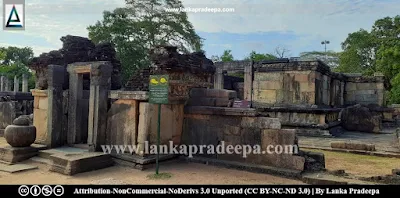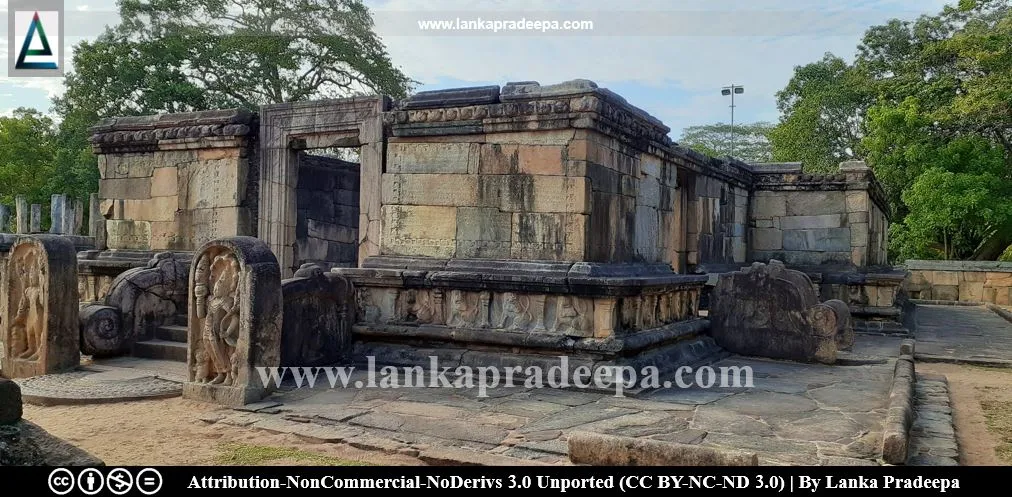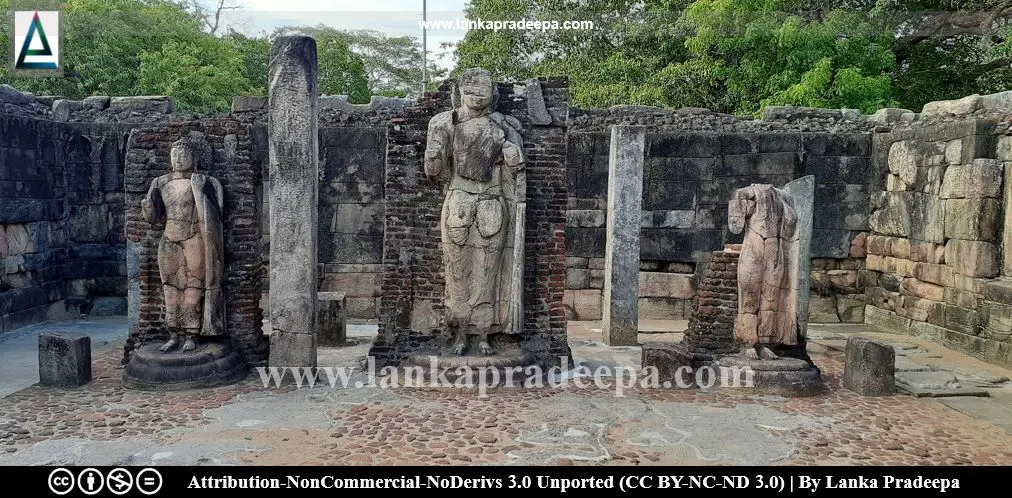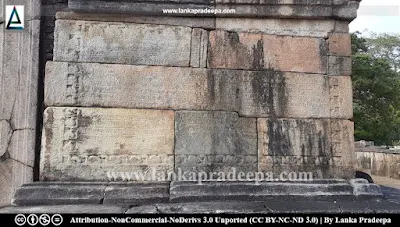
Hetadage (pronounce as Hætadage) is a relic shrine located in the Ancient City of Polonnaruwa, Sri Lanka. It stands in the Sacred Quadrangle facing the Vatadage Shrine.
History
Hetadage building has been identified as the ancient Temple of the Tooth Relic built by King Nissankamalla [(1187-1196 A.D.) Nicholas, 1963; Paranavitana, 1950]. The building is called Hetadage because it is said that it was built within sixty (Sinhala: Heta) hours, i.e. one single day (Ray, 1960). In the Sinhalese Language, the word Hæta means sixty and Dage means the relic shrine. However, another theory suggests that this building is so named because it held sixty relics.
The structure was restored by King Vijayabahu IV (1270-1272 A.D.) of the Dambadeniya Kingdom (Nicholas, 1963).
The building
Hetadage was a two-storied building and is apparently a larger version of the design of the Atadage building (Prematilleke, 1990). The upper storey has now been destroyed and the brick and stone walls of the lower storey remain today. The sacred Tooth Relic of the Buddha may have been deposited in the upper storey.
 The edifice is standing within a stone-walled enclosure of about 120 ft long and 90 ft wide (Prematilleke, 1990; Ray, 1960). The wall had been constructed of brick and faced with irregular stone slabs on both sides (Prematilleke, 1990). A portico of the enclosure provides the entrance to the edifice and its passage had a roof supported on pillars (Prematilleke, 1990). After the portico, the main entrance to the edifice accompanied by a Sandakada Pahana (moonstone), Muragal (guard stones) and Korawak Gal (wingstones) is found. The main entrance leads to a small vestibule and at its left corner is a staircase of nine steps running to the upper storey which can not be seen today (Ray, 1960). Besides the main entrance, another smaller doorway is found on the eastern side of the edifice.
The edifice is standing within a stone-walled enclosure of about 120 ft long and 90 ft wide (Prematilleke, 1990; Ray, 1960). The wall had been constructed of brick and faced with irregular stone slabs on both sides (Prematilleke, 1990). A portico of the enclosure provides the entrance to the edifice and its passage had a roof supported on pillars (Prematilleke, 1990). After the portico, the main entrance to the edifice accompanied by a Sandakada Pahana (moonstone), Muragal (guard stones) and Korawak Gal (wingstones) is found. The main entrance leads to a small vestibule and at its left corner is a staircase of nine steps running to the upper storey which can not be seen today (Ray, 1960). Besides the main entrance, another smaller doorway is found on the eastern side of the edifice.
After the vestibule is the Garbhagrha (sanctum) where three standing Buddha statues carved out of granite rock are found. The sanctum is square in shape and each of its sides is 47 ft in length [(externally) Ray, 1960]. A wide circumambulatory is also visible inside the sanctum. The roof of the edifice may have had wooden beams covered with clay tiles.
Inscriptions
Three inscriptions of King Nissankamalla are found among the stone slabs on the Hetadage walls: one on the porch and two on the shrine (Wickremasinghe, 1928). They were discovered by S.M. Burrows in 1885 while removing the debris from this site (Wickremasinghe, 1928). The inscriptions record about king's offerings, altruistic activities and also about advice given to the community of Buddhist monks by him.
Reign : Nissankamalla (1187-1196 A.D.)
Period : 12th century A.D.
Script : Medieval Sinhala
Language : Medieval Sinhala
Contents;
(Note: This section contains information directly extracted from the details given in the public information board at the site by the Department of Archaeology and the Ministry of National Heritage.)
Hetadage portico slab inscription
The Dharma which gives happiness and which alone deserves to be honoured in the whole world should always be preserved.
King Nissankamalla was born in Sinhapura of Kalinga, of the womb of Queen Parvati unto Sri Jayagopa. In regular order, he was consecrated as the king of Sri Lanka. The king waived taxes for five years and did many meritorious acts. The king toured through the three kingdoms and promoted the welfare of the state and the Sasana. Although the king proceeded to Dambadiva (India) and demanded war the Pandyans and the Colas did not fight but sent gold, gifts, and maidens. Since there were no enemies in this world the king thought to win the enemies of the next world and did many meritorious acts. To venerate the Tooth Relic and Bowl Relic he offered his son Virabahu and his daughter Sarvanga Sundari and for the purpose of redeeming them caused to make a Stupa in gold. He also built Vatadageya, Nissanka Lata Pavillion and Nissanka Tooth Relic House and dedicated to them many villages, lands, and serfs.
May the future kings protect the Dharma and secure the welfare of both worlds! Let it be thus understood by future kings that these are the virtuous sentiments of King Nissankamalla.
Hetadage vestibule wall inscription
From the second year of accession, King Nissankamalla toured around Lanka including places such as Samanola (Sri Pada/Adam's peak). He freed the kingdom from lawlessness thoroughly, that a woman might even carry a casket filled with the nine kinds of gems and not be asked, 'what is that?'
After living in a palace built by another king for seven years and seven months he thought it does not fit for his (status). He erected within 45 days a palace of seven stories. He built a magnificent pavilion from which he watched elephant fights. The king built ramparts and gates, three stone pavilions and Kalinga Park. He got his queens from Kalinga, Vanga, Karnataka, Gujarati, etc. and built for them separate palaces.
In the three kingdoms, he erected palaces at several places and built stone thrones named 'Virasimhasana'. He suppressed various administrative injustices. In the cause of thus inspecting the three kingdoms in various ways, he fixed a Gavu (mileposts) calling it Nissanka-gave (several of these have been found).
The king made annual donations (in coins) to the poor equivalent to weights of himself, Queen Subhadra, sub-queen Kalyana, sub-king Virabahu, minister Vikramabahu, Queen Candra, and their Highnesses Parvati and Sarvanga Sundari.
Hetadage inside wall inscription
Although the venerable ones, teachers and preceptors practice the established doctrines and discipline, the kings are responsible for the protection of the Sasana of the country for the continuation of the religion for 5000 years. Accordingly, for the safety of the Sasana the king thus advises;
The venerable ones who are teachers and preceptors should not, without inquiry robe foolish, sinful, false and crafty persons.
They should not do improper things contrary to the teachings of the Buddha,
(The inscription is damaged and the rest cannot be read)



.
References
1) Nicholas, C. W., 1963. Historical topography of ancient and medieval Ceylon. Journal of the Ceylon Branch of the Royal Asiatic
Society, New Series (Vol VI). Special Number: Colombo. Royal Asiatic
Society (Ceylon Branch). p.178.
2) Paranavitana, S. 1950. Guide to Polonnaruwa. Govt Press, Colombo. p.13.
3) Prematilleke, L., 1990. The architecture of the Polonnaruwa Period B.C.800-1200 A.D. Wijesekara, N. (Editor in chief). Archaeological Department centenary (1890-1990): Commemorative series: Volume III: Architecture. Department of Archaeology (Sri Lanka). pp.50-51.
4) Ray, H. C. (Editor in Chief), 1960. University of Ceylon: History of Ceylon (Vol 1, part II). Ceylon University Press. pp.573,599.
5) Wickremasinghe, D. M. D. Z., 1928. Epigraphia Zeylanica: Being lithic and other inscriptions of Ceylon (Vol, II). Published for the government of Ceylon by Humphrey Milford. pp.84-98.
Location Map
This page was last updated on 14 November 2022





